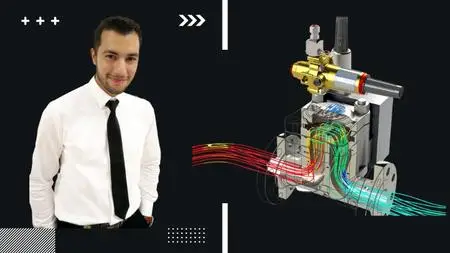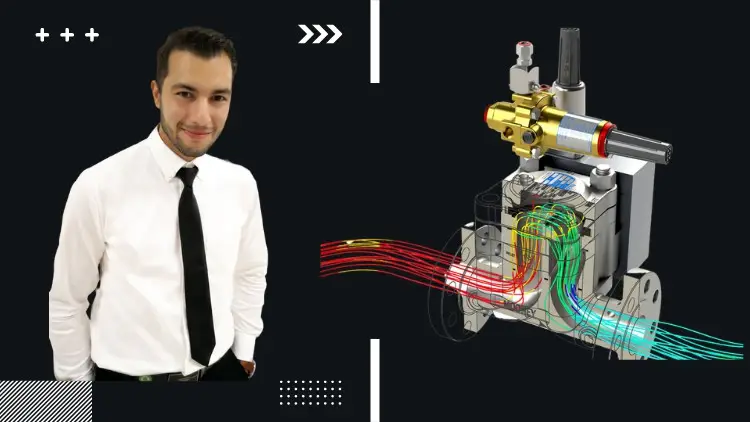Solidworks particle study documentation
Duration: 2h 49m | .MP4 1280x720, 30 fps(r) | AAC, 44100 Hz, 2ch | 1.58 GB
Genre: eLearning | Language: English
Duration: 2h 49m | .MP4 1280x720, 30 fps(r) | AAC, 44100 Hz, 2ch | 1.58 GB
Genre: eLearning | Language: English
Learn CFD with Solidworks
What you'll learn
Learners will know the precise procedures for carrying out any parametric analysis with SolidWorks.
Understanding the process for applying Computational Fluid Dynamics to solve any industrial challenge (CFD)
By using SolidWorks Flow Simulation, students will be able to use SolidWorks at an expert level to address any engineering challenge.
Students will be taught about various boundary conditions.
Learners will be able to use SolidWorks Flow Simulation to optimize any industrial challenge.
Students will have a thorough understanding of CFD Optimization at an expert level.
Requirements
Be already familiar with Solidworks User Interface
Have had previous experience designing various geometry with Solidworks
Have some background knowledge in CFD Computational Fluid Dynamics or similar fields
Recommended but not mandatory: has completed one of my previous courses related to Solidworks design tips and tricks
Description
Solidworks particle study documentation
Note:
the course will be updated regularly, so expect more lessons to come in the near future.
CFD analysis and optimization using SolidWorks topics are covered in every video. The videos discuss problems unique to their industry and illustrate them with straightforward examples. This course was developed with intermediate and advanced students in mind.
Unit 1:
The Effects of Reduced Nozzle Size and Obstacles on the Flow of Fluids
Learning outcome:
Students will be able to solve the characteristics of flowing stream in a reduction nozzle.
Problem:
Find the characteristics of the flowing stream in a nozzle, knowing that a sphere is located in the space between the higher diameter pipe and the reduction zone.
Questions to solve:
The average velocity at the outlet.
Velocity flow field.
Pressure distribution within the fluid.
Pressure at the surface of the sphere.
Pressure at the surface of the duct.
Unit 2: Loss coefficient calculations under different conditions
Learning outcome:
Students will be able to estimate the loss coefficient under different operating levels.
Problem:
Estimate the loss coefficient in a ball valve under different opening levels.
Questions to solve:
Given the formulas for loss of coefficient and
Reynolds number, we will
find:
The calibration curve when the valve opening is at 0 degrees.
The calibration curve when the valve opening is at 10 degrees.
The calibration curve when the valve opening is at 15 degrees.
The calibration curve when the valve opens at 20 degrees
extract the data into an excel sheet and graph all the results at different angles.
Unit 3: Fluid characteristics of a counter-current heat exchanger
Learning outcome:
Students will be able to set custom equations to solve complex heat transfer problems.
Objectives:
Set up a heat transfer model using the Simulation add-in in Solidworks
Show how to specify fluid subdomains when multiple fluids are required.
Show how to specify solid domains.
Set custom equations by using the Goals feature.
Problem:
Simulate a counter-current two-pipe heat exchanger.
Questions to solve:
Determine:
The outlet temperature of both streams.
Display the inlet and outlet velocities of both streams.
Display a Cut Plot for the temperature.
Display a flow trajectory plot for the temperature.
Estimate the Log Mean Temperature Difference (LMTD).
Unit 4:
The Effects of ventilation systems on the CO2 within an indoor space
Description:
COVID-19 has been a major public health concern after its outbreak in early 2020. An indirect way of estimating the probability of the presence of the SARS-CoV-2 in an indoor environment is by measuring the concentration of CO2 in the air. CO2 is a regular component of the air at a concentration of around 400ppm. However, in poorly ventilated facilities, this concentration can rise to an unsafe level.
Problem:
Simulate the ventilation of a classroom with an initial CO2 concentration in the air of 900 ppm. Use a time-dependant approach to track the change in concentration in the room.
Questions to solve:
Determine:
Demonstrate the use of the design features such as: Convert Entities, Extruded Cut, and Extruded Boss/Base
Simulate the transport of multiple species.
Demonstrate how to specify the presence and concentration values of multiple species.
Demonstrate how to specify a time-dependant model.
I really hope that this course will benefit everyone. If you have any questions, please write to me and I will make sure to answer your questions.
I wish everyone success in their life, whether it be for their studies or career. Have a great day ahead!
Solidworks particle study documentation is for anyone who would like to do CFD analysis.
Keywords:
Solidworks simulation , CFD parametric study optimization , professional spring Solidworks , curso Solidworks , Solidworks download, Solidworks certification , draft points in Solidworks , Solidwork , que es Solidworks , descargar solidworks , Solidworks Udemy course
Who this course is for:
Advance users who are engineering students at the University
Professional users working in an industry related to engineering or fluid quality control
CAD/CAM/CAE professionals
More Info



